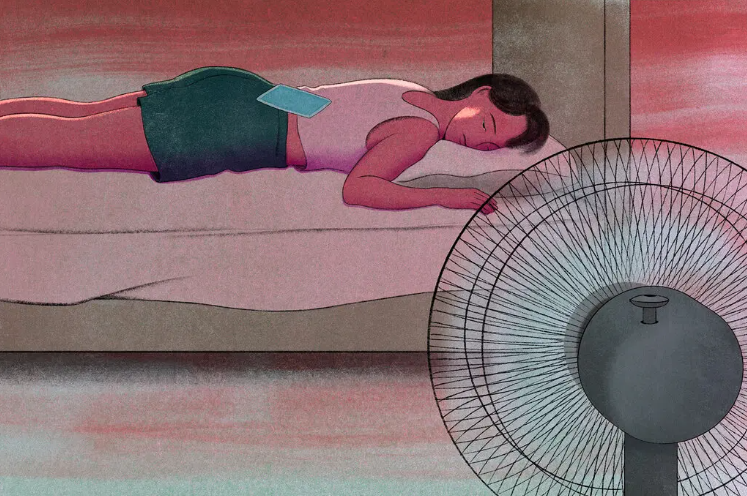
Jo Zixuan Zhou
As we welcome August, most people are filled with joy and excitement to continue with their summer plans. Summer is supposed to be a time of fun and relaxation after all; yet for those with summer depression, this season can be far from pleasant.
You have likely heard about Seasonal Affective Disorder (SAD), a type of depression that happens during certain seasons of the year. Most people associate this with the ‘Winter Blues,’ which occur because symptoms of depression arise due to the shorter days and loss of daylight, causing a chemical change in the brain. There are 2 types of SAD: fall-onset (winter depression) and spring-onset (summer depression). Despite this fact, when examining seasonal depression, summer depression is often overlooked both by the public and in research.
Symptoms and signs of summer depression are different for everyone, but some common ones are:
- Persistent sad, anxious, or agitated mood
- Feelings of hopelessness, frustration, guilt
- Loss of interest/pleasure in previously enjoyed activities
- Insomnia and difficulty sleeping
- Lack of appetite, leading to weight loss
- Violent and aggressive behaviour
- Difficulty thinking, making decisions, and concentrating
- Suicidal thoughts
There is not just one factor that contributes to summer depression but researchers have found multiple possible causes. The main theory is that as seasons change, it causes people to face a shift in their circadian rhythm, which is their biological internal clock. This shift disrupts their daily schedules and routines. Routines like a healthy sleep or exercise schedule are essential for reducing stress and maintaining a positive state of wellbeing. Therefore, when these patterns are suddenly disrupted, it harms people’s physical and mental health.
Other possible causes are:
- Reduced melatonin levels: The serotonin and melatonin hormones help maintain the body’s daily rhythm, which is linked with the seasonal night-day cycle. Furthermore, the long, hot days can lead to symptoms of depression because of the reduced melatonin levels. People with SAD can not adjust to these seasonal changes which cause their sleep, mood, and behaviour changes.
- Heat and humidity: Some studies suggest that compounds in the body such as norepinephrine, serotonin, and dopamine regulate mood as well as body temperature. Therefore, the heat and humidity can trigger people, making them vulnerable.
- Pollen: Another possible factor is pollen as the immune response to this allergen causes multiple changes in the body, including the release of cytokines, which are biological compounds that have been connected to depression.
There are 4 main treatment categories that can be used alone or in a combination to help people with SAD: light therapy, vitamin D, antidepressant medication, and psychotherapy.
Light therapy and vitamin D are used for treating winter-pattern SAD. In light therapy, a person sits in front of a light box 20 times brighter than the average light, everyday for 30-45 minutes which aims to compensate for the diminished natural sunlight. Many people with winter-pattern SAD also suffer from vitamin D deficiency so supplements can help improve symptoms.
Antidepressants and psychotherapy are used for treating both types of SAD. Antidepressants change how the brain produces and uses chemicals involved in mood or stress and take 4-8 weeks to work. For example, selective serotonin reuptake inhibitors (SSRIs), a type of antidepressant that improves a person’s mood, are used to help with disturbance in serotonin activity.
Psychotherapy is also helpful when changing habits and ways of thinking that contribute to depression. Cognitive behavioural therapy, is a type of psychotherapy that has been adapted for people with SAD, known as CBT-SAD. This focuses on replacing negative thoughts related to the season, like the heat of summer with more positive notions. It usually takes place for 6 weeks in group sessions and can also involve behavioural activation, a process that guides people to identify and plan activities that will help with the loss of interest they are experiencing.
Some other coping strategies are avoiding social isolation, engaging in regular daily activities, maintaining a healthy diet, following an eating and sleeping schedule, and understanding why this season is a difficult time in order to break the cycle.
Awareness and understanding are essential for addressing summer depression. Recognizing the symptoms, causes, treatment options, and coping strategies is imperative in order to better manage mental health and prevent the sunshine from bringing sadness.
Works Cited
McMahon, Grace, et al. “Disruption to Well-Being Activities and Depressive Symptoms during the COVID-19 Pandemic: The Mediational Role of Social Connectedness and Rumination.” Journal of Affective Disorders, U.S. National Library of Medicine, 15 July 2022, www.ncbi.nlm.nih.gov/pmc/articles/PMC9044653/.
Northwestern Medicine. “Health Benefits of Having a Routine.” Northwestern Medicine, www.nm.org/healthbeat/healthy-tips/health-benefits-of-having-a-routine.
“Seasonal Affective Disorder (SAD).” Psychiatry.Org - Seasonal Affective Disorder (SAD), www.psychiatry.org/patients-families/seasonal-affective-disorder#:~:text=About%205%25%20of%20adults%20in,about%2040%25%20of%20the%20year.
“Seasonal Affective Disorder.” National Institute of Mental Health, U.S. Department of Health and Human Services, www.nimh.nih.gov/health/publications/seasonal-affective-disorder#part_6696.
“You’ve Heard of the Winter Blues but What about Summer Depression?” CAMH,“Seasonal Affective Disorder.” National Institute of Mental Health, U.S. Department of Health and Human Services, www.nimh.nih.gov/health/publications/seasonal-affective-disorder#part_6696.
“You’ve Heard of the Winter Blues but What about Summer Depression?” CAMH, www.camh.ca/en/camh-news-and-stories/summer-depression.
